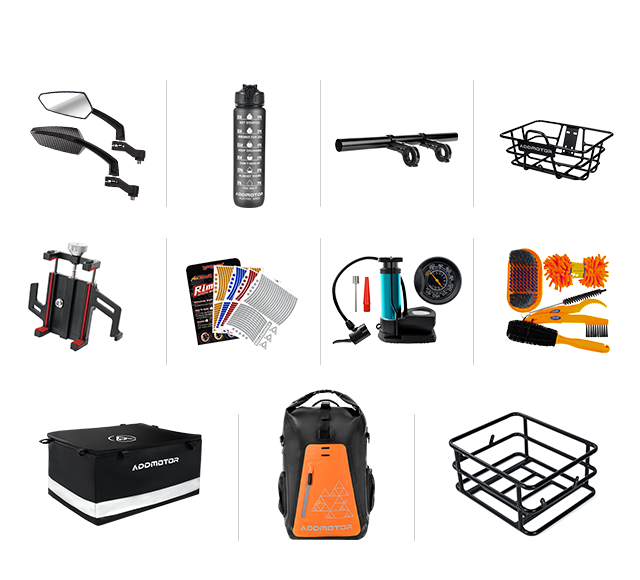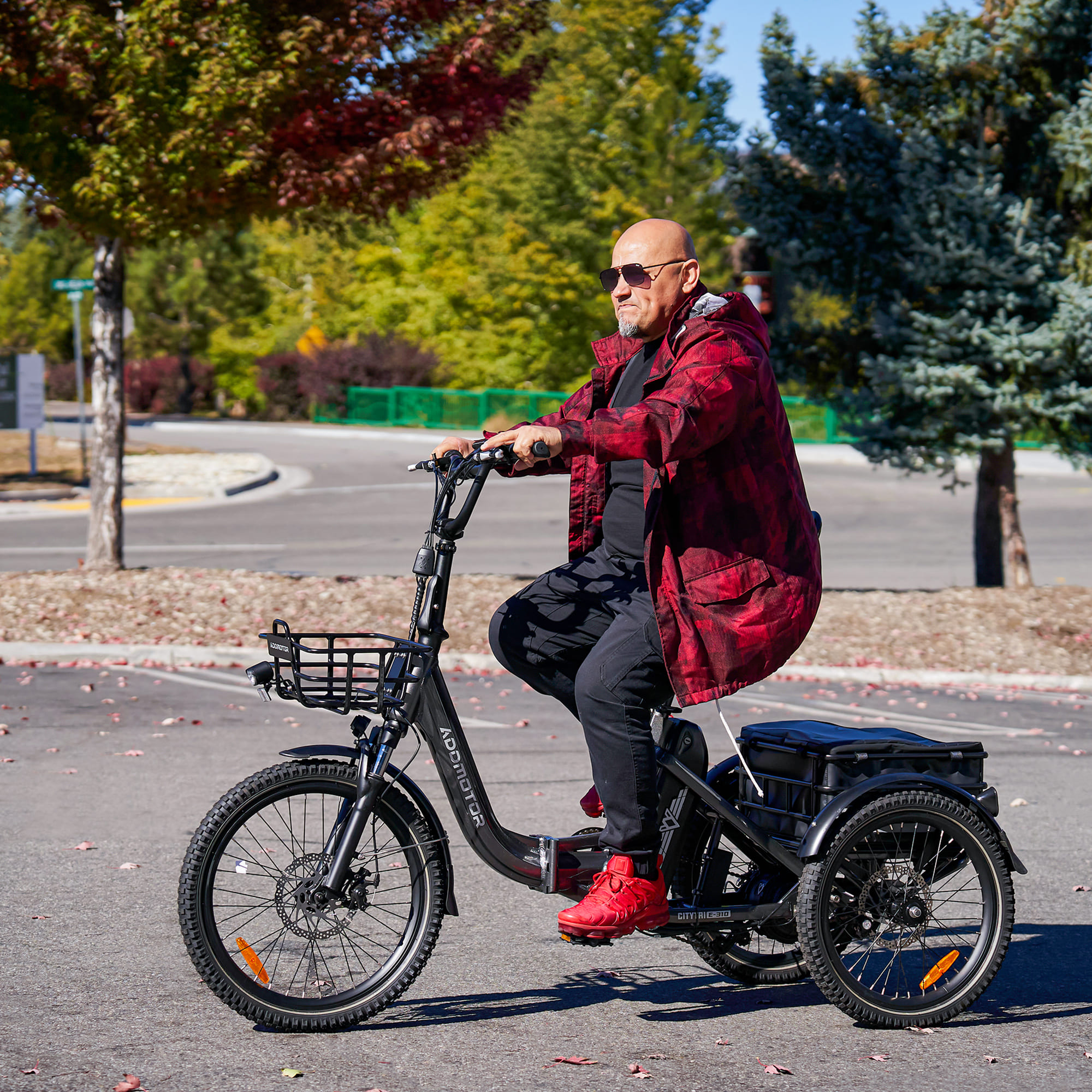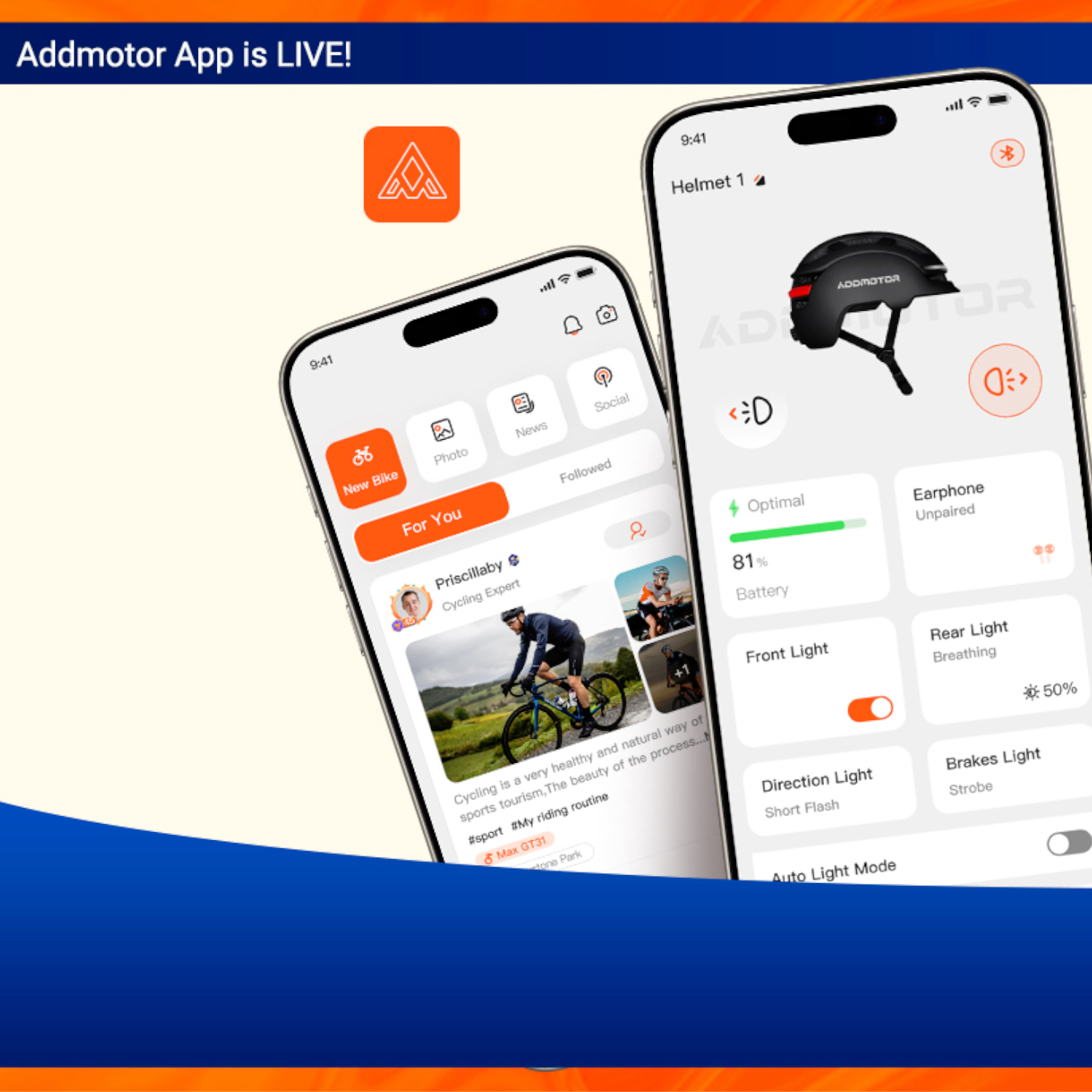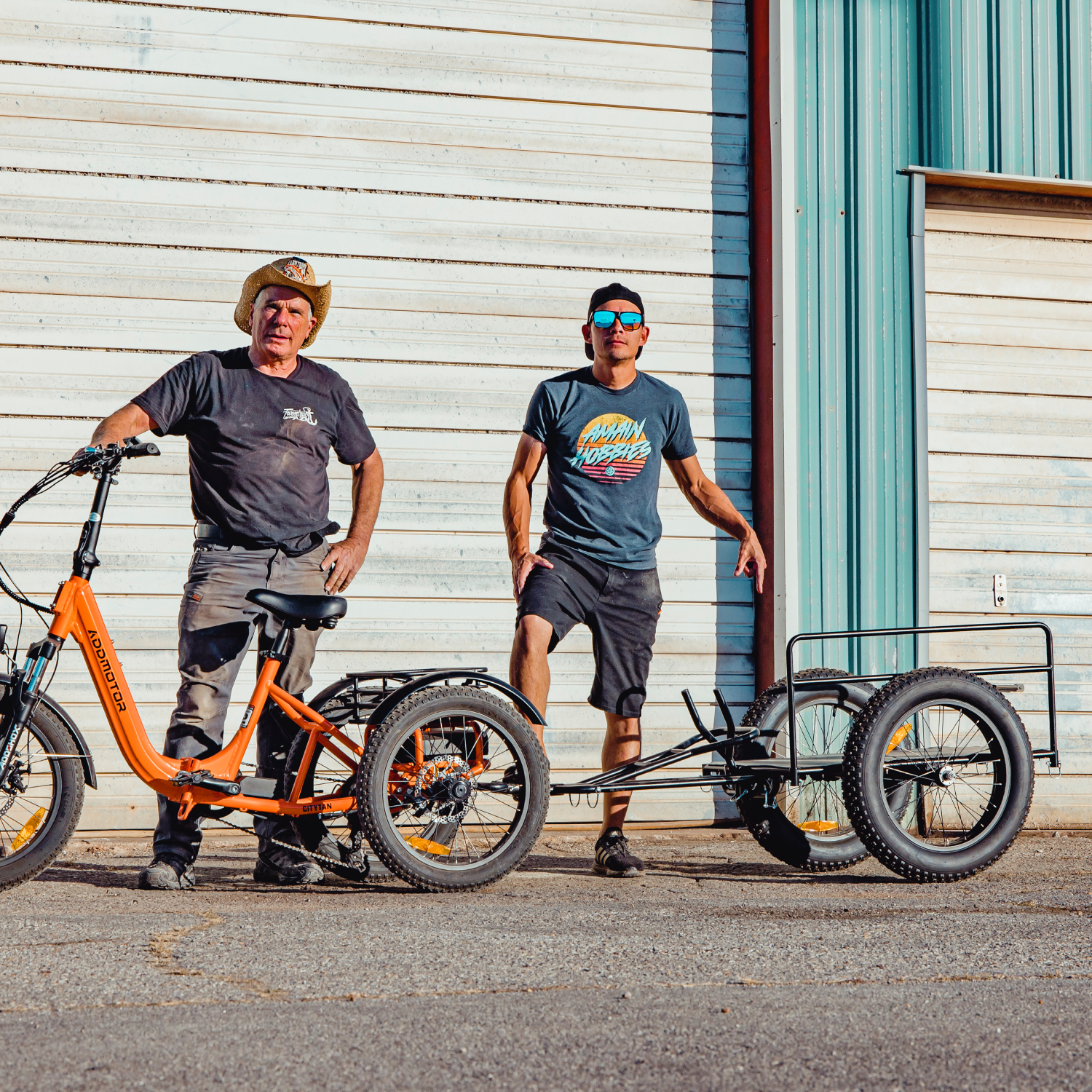Mechanical vs Hydraulic Disc Brakes on Electric Trikes
By Addmotor | 20 December 2023 | 1 Comments
Brakes are one of the most crucial components in any vehicle, including electric trikes and electric bikes. Properly functioning brakes keep riders safe and prevent unnecessary crashes and accidents.
Two of the most common braking mechanisms are mechanical and hydraulic disc brakes. Generally, hydraulic disc brakes tend to be the more high-end option. That said, mechanical disc brakes are more viable for a variety of reasons.
So let’s compare these two and discuss how you can pick one that fits your riding style.
However, in the case of electric trikes, simple brakes designed for push bicycles just won’t cut it. Adult electric trikes tend to be heavier and gain a lot of traction. They need special brakes with greater stopping power and more exacted modulation (sensitivity).
On top of that, electric trikes also need to account for the performance of the electrical motor. For this, a motor cutoff switch is directly integrated into the braking system. The motor cutoff switch depowers the motor whenever you press the brake handle. So essentially, you're stopping the wheels and the motor at the same time. For electric trikes, a motor cutoff switch is a crucial safety feature. It prevents the motor from burning out and stops the trike from careening forward.
Our Addmotor GRANDTAN is the most versatile eTrike in our lineup. It’s got full-wheel Tektro mechanical disc brakes with a motor cutoff switch built-in.
When the levers are pulled towards the handlebar, the cable inside pulls up as well. This pushes the brake pads onto the rotor (or disc).
The rotor then creates friction in the wheel, causing it to slow down.
In a mechanical disc brake setup, they directly signal the brake pads. The brake calipers then apply pressure onto the rotor (disc brake), creating friction.
In a hydraulic system, the cables actuate the piston in the brake fluid reservoir. The piston then pushes in hydraulic fluid to the calipers which compress onto the rotor.
The calipers sit on either side of the disc brake. They compress together whenever the rider pulls on the brake lever.
In hydraulic brake systems, the calipers are compressed and retracted using the fluid. Meanwhile, in mechanical systems, the calipers are controlled directly by the cables.
The rotor’s function is to convert the kinetic energy of the wheels and convert them into heat energy. As a result of this conversion, friction is created and the wheels start to slow down.
This switch includes sensors (such as magnets) that send out a signal when the brake lever is pulled. The controller takes in this signal and overrides the motor to power down.
The motor cutoff switch is another crucial component. It keeps the motor synchronized with the brakes so it doesn't wear out or cause the bike to dash forward uncontrollably.
For hydraulic disc brakes, a fluid (typically an oily substance) is used as the actuator.
Here, the fluid is transferred from a reservoir into a smaller chamber using a piston. This action can provide a proportional amount of force. In turn, it's enough to allow the calipers to clamp down on the rotor with greater efficiency.
Because of the fluid, you can provide high stopping power with less effort. On top of that, the hydraulic action offers a greater degree of control over the calipers.
At Addmotor, we reserve hydraulic brakes for more heavy-duty and all-terrain eBikes. The best example is our Foldtan M-160 Bike.
This system isn’t the most efficient and doesn’t offer more exacted control. You either pull the lever to engage the brakes or let go to disengage. There is rarely anything going on in between.
Also, mechanical brakes are easier to maintain and tend to be more affordable.
Check out this article to learn more about mechanical disc brakes on eBikes.
In mechanical brakes, the cable connected to the lever applies a discrete amount of force so the calipers can latch onto the disc.
Mechanical systems have significantly lower degrees of control and stopping power. They are less sensitive to how hard you pull the brake levers. On top of that, they are less responsive and need a good second or two to stop a fast-moving bike.
Hydraulic systems have greater stopping power. This means shorter stopping distances compared to mechanical systems.
Meanwhile, with a mechanical system, you’d typically have to pull the lever all the way back. As such, you need to put in more effort for higher stopping power.
- You primarily use the eTrike for city cruising and commuting on smooth paved roads.
- You ride at slower speeds
- You want a budget-friendly alternative
- You want to repair and service the eTrike yourself
- You don’t want to carry out extensive inspections or costly maintenance every time.
Conversely, hydraulic brakes are best for heavy-duty riders. Especially those who ride at higher speeds, haul cargo, or do the majority of their riding off-road.
If a braking system cannot cool down quickly, it results in a condition called brake fade. Here, the brake pads won’t provide as much stopping power as they’re still “hot” from the previous braking action.
In this case, hydraulic or mechanical rarely makes a difference. Here, it’s the disc or the rotor that does most of the work in dissipating heat. So if you’re looking for optimal performance, pick out a high-end disc brake setup from a reputable brand. It doesn’t matter whether it’s mechanical or hydraulic.
At Addmotor, our high-end GRANDTAN Turbo relies on Tektro brand mechanical disc brakes. They provide impressive stopping power, even compared to hydraulic brakes from other brands.
So consider where and how you’ll be riding your electric trike or electric bike. Then, pick the system that’s ideal for you.
At Addmotor, the majority of our trikes and eBikes do amazing with mechanical disc brakes. Hydraulic brakes are reserved for eBikes that specialize in high-speed and off-roading.
Two of the most common braking mechanisms are mechanical and hydraulic disc brakes. Generally, hydraulic disc brakes tend to be the more high-end option. That said, mechanical disc brakes are more viable for a variety of reasons.
So let’s compare these two and discuss how you can pick one that fits your riding style.
What’s Special About Brakes in Electric Trikes?
We all know that the basic principle of brakes is to slow down an eTrike and make it easier to maneuver.However, in the case of electric trikes, simple brakes designed for push bicycles just won’t cut it. Adult electric trikes tend to be heavier and gain a lot of traction. They need special brakes with greater stopping power and more exacted modulation (sensitivity).
On top of that, electric trikes also need to account for the performance of the electrical motor. For this, a motor cutoff switch is directly integrated into the braking system. The motor cutoff switch depowers the motor whenever you press the brake handle. So essentially, you're stopping the wheels and the motor at the same time. For electric trikes, a motor cutoff switch is a crucial safety feature. It prevents the motor from burning out and stops the trike from careening forward.
Our Addmotor GRANDTAN is the most versatile eTrike in our lineup. It’s got full-wheel Tektro mechanical disc brakes with a motor cutoff switch built-in.
The Crucial Components of Any eTrike Braking System
Lever
The lever is the mechanism that takes input from the rider to engage or disengage the brake. On eBikes, the brake lever is installed in the handlebars. There are two levers with each controlling the brakes at either the front or rear wheel.When the levers are pulled towards the handlebar, the cable inside pulls up as well. This pushes the brake pads onto the rotor (or disc).
The rotor then creates friction in the wheel, causing it to slow down.
Brake Cables
The brake cables actuate the entire braking system by taking the input from the brake levers.In a mechanical disc brake setup, they directly signal the brake pads. The brake calipers then apply pressure onto the rotor (disc brake), creating friction.
In a hydraulic system, the cables actuate the piston in the brake fluid reservoir. The piston then pushes in hydraulic fluid to the calipers which compress onto the rotor.
Calipers
The brake calipers hold the brake pads. The brake pads are what come into contact with the rotor and generate friction.The calipers sit on either side of the disc brake. They compress together whenever the rider pulls on the brake lever.
In hydraulic brake systems, the calipers are compressed and retracted using the fluid. Meanwhile, in mechanical systems, the calipers are controlled directly by the cables.
Disc Brake/Rotor
The disc brake, or rotor, is directly connected to the wheels. As such, the disc brake rotates at the same speed as the wheel and helps slow it down when the calipers push in.The rotor’s function is to convert the kinetic energy of the wheels and convert them into heat energy. As a result of this conversion, friction is created and the wheels start to slow down.
Motor Cutoff Switch
The motor cutoff switch is exclusive to electric bikes and trikes. This switch automatically shuts down the motor whenever the rider pulls on the brake.This switch includes sensors (such as magnets) that send out a signal when the brake lever is pulled. The controller takes in this signal and overrides the motor to power down.
The motor cutoff switch is another crucial component. It keeps the motor synchronized with the brakes so it doesn't wear out or cause the bike to dash forward uncontrollably.
How Do Hydraulic Brakes Work?
The basic concept of disc brakes remains the same. However, these two options use different mechanisms to apply pressure on the rotor. Hence, they lead to different results and use cases.For hydraulic disc brakes, a fluid (typically an oily substance) is used as the actuator.
Here, the fluid is transferred from a reservoir into a smaller chamber using a piston. This action can provide a proportional amount of force. In turn, it's enough to allow the calipers to clamp down on the rotor with greater efficiency.
Because of the fluid, you can provide high stopping power with less effort. On top of that, the hydraulic action offers a greater degree of control over the calipers.
At Addmotor, we reserve hydraulic brakes for more heavy-duty and all-terrain eBikes. The best example is our Foldtan M-160 Bike.
How Do Mechanical Brakes Work?
Mechanical disc brakes take on a simpler approach. They cut the hydraulic middleman and simply use the lever cables to actuate the calipers.This system isn’t the most efficient and doesn’t offer more exacted control. You either pull the lever to engage the brakes or let go to disengage. There is rarely anything going on in between.
Also, mechanical brakes are easier to maintain and tend to be more affordable.
Check out this article to learn more about mechanical disc brakes on eBikes.
Differences Between Mechanical and Hydraulic Brakes
Operating Principle
As mentioned, the main point of difference is in how they actuate the brake calipers. Hydraulic systems use a fluid to apply the clamping force into the rotors.In mechanical brakes, the cable connected to the lever applies a discrete amount of force so the calipers can latch onto the disc.
Stopping Power and Modulation
Hydraulic systems tend to be more versatile and responsive. They can provide instant stopping power or gradually modulate the braking force at will.Mechanical systems have significantly lower degrees of control and stopping power. They are less sensitive to how hard you pull the brake levers. On top of that, they are less responsive and need a good second or two to stop a fast-moving bike.
Hydraulic systems have greater stopping power. This means shorter stopping distances compared to mechanical systems.
Brake Lever Control and Effort
In terms of lever control, hydraulic systems are instant and require minimal effort. You only have to pull on the brakes for less than an inch for the calipers to fully latch onto the rotor.Meanwhile, with a mechanical system, you’d typically have to pull the lever all the way back. As such, you need to put in more effort for higher stopping power.
Cost and Complexity
Hydraulic braking systems are more complicated as they require costed components. As such, eBikes and trikes with hydraulic disc brakes tend to be more expensive. Meanwhile, the simplicity of mechanical disc brakes is one of its strong points. They are affordable and usually the best option for casual-use eBikes and trikes.Maintenance and Durability Aspects
Hydraulic braking systems can be extremely costly and difficult to repair and maintain. They need constant inspections and you must take them to an authorized bike shop to service them. Meanwhile, mechanical brake systems are DIY-friendly and won’t demand that much attention. Their parts are commonplace and affordable and you can work on them by yourself.Quick Guide to Decide Between Mechanical or Hydraulic Disc Brakes
When deciding between mechanical or hydraulic systems, ensure you consider the above factors. However, as a rule of thumb, go for mechanical disc brakes over hydraulic if:- You primarily use the eTrike for city cruising and commuting on smooth paved roads.
- You ride at slower speeds
- You want a budget-friendly alternative
- You want to repair and service the eTrike yourself
- You don’t want to carry out extensive inspections or costly maintenance every time.
Conversely, hydraulic brakes are best for heavy-duty riders. Especially those who ride at higher speeds, haul cargo, or do the majority of their riding off-road.
Heat Dissipation Performance: Another Crucial Factor to Consider
A good braking system immediately converts kinetic energy to heat. It then dissipates that heat as fast as possible before the next instance brakes are applied.If a braking system cannot cool down quickly, it results in a condition called brake fade. Here, the brake pads won’t provide as much stopping power as they’re still “hot” from the previous braking action.
In this case, hydraulic or mechanical rarely makes a difference. Here, it’s the disc or the rotor that does most of the work in dissipating heat. So if you’re looking for optimal performance, pick out a high-end disc brake setup from a reputable brand. It doesn’t matter whether it’s mechanical or hydraulic.
At Addmotor, our high-end GRANDTAN Turbo relies on Tektro brand mechanical disc brakes. They provide impressive stopping power, even compared to hydraulic brakes from other brands.
Wrapping Up
Brakes are important but going for hydraulic disc brakes isn’t always the best option. Typically, you want to consider the long-term aspects, especially if you’re a casual user. This means, ease of maintenance, lower operating costs, and increased durability.So consider where and how you’ll be riding your electric trike or electric bike. Then, pick the system that’s ideal for you.
At Addmotor, the majority of our trikes and eBikes do amazing with mechanical disc brakes. Hydraulic brakes are reserved for eBikes that specialize in high-speed and off-roading.
Recently Reviews
Read MoreLeave a Reply
Your email address will not be published.Required fields are marked. *
Latest Stories

-(1)_1703140899.jpg)



